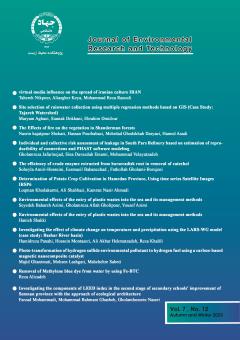The efficiency of crude enzyme extracted from horseradish root in oxidation of catechol
Subject Areas : Water and wastewater technologySoheila Amiri Hosseini 1 , Fatemeh Nejatzadeh 2 , Eesmaeil Babanezhad 3 , fathollah gholami 4 *
1 - MSc student in Environmental Health Engineering, Faculty of Health, Mazandran university Sciences, Sari, Iran
2 - Department of Horticulture, Faculty of Agriculture, Khoy Branch, Islamic Azad University, Khoy, Iran
3 - Department of Environmental Health Engineering, Faculty of Health, Mazandran University of Medical Sciences, Sari, Iran
4 -
Keywords: Enzyme, Horse radish peroxidase, Catechol, Synthetic wastewater,
Abstract :
Catechol is one of the phenolic compounds (with chemical formula (C6H6O2) which is used as a raw material or final product of chemical, petrochemical and oil refineries. In this study, the efficiency of horseradish extract as a gross enzyme and removal of catechol from industrial wastewater was investigated. In order to study the efficiency of variable enzyme processes (20, 10, 40, ml / l), oxygenated water concentrations (0.58, 1.17, 2.35 mol / l) were evaluated for 20 minutes. The output catechol concentration of the process was measured by HPLC at a wavelength of 275 nm. The results of this study showed that with increasing the volume of oxygenated water and keeping the concentration of the enzyme constant, an increasing trend was observed at first, but after a while with a further increase in hydrogen peroxide, no significant change in efficiency was observed. For concentrations of hydrogen peroxide (0.58, 1.17, 1.78 mol / L) and hydrogen peroxide (10, 20, 40 ml / L), removal efficiencies of 45%, 60% and 80% were obtained, respectively. However, with the values of oxygenated water concentrations (1.17, 2.35, 3.53 mol / l) and fixed oxygenated water concentrations, the removal efficiency was 42%, 58% and 81%, respectively. Enzymatic treatment process as a suitable process can be used for catechol and its compounds from wastewater. To obtain the appropriate efficiency, it is better to set it in the optimal conditions under optimal conditions and add variables in the reaction.
1. Libutti A, Gatta G, Gagliardi A, Vergine P, Pollice A, Beneduce L, et al. Agro-industrial wastewater reuse for irrigation of a vegetable crop succession under Mediterranean conditions. Agricultural Water Management. 2018;196:1-14.
2. Udaiyappan AFM, Hasan HA, Takriff MS, Abdullah SRS. A review of the potentials, challenges and current status of microalgae biomass applications in industrial wastewater treatment. Journal of Water Process Engineering. 2017;20:8-21.
3. Threrujirapapong T, Khanitchaidecha W, Nakaruk A. Treatment of high organic carbon industrial wastewater using photocatalysis process. Environmental nanotechnology, monitoring & management. 2017;8:163-8.
4. Bayramoğlu G, Arıca MY. Enzymatic removal of phenol and p-chlorophenol in enzyme reactor: horseradish peroxidase immobilized on magnetic beads. Journal of hazardous materials. 2008;156(1-3):148-55.
5. Kalaiarasan E, Palvannan T. Removal of phenols from acidic environment by horseradish peroxidase (HRP): aqueous thermostabilization of HRP by polysaccharide additives. Journal of the Taiwan Institute of Chemical Engineers. 2014;45(2):625-34.
6. Nazari K, Esmaeili N, Mahmoudi A, Rahimi H, Moosavi-Movahedi A. Peroxidative phenol removal from aqueous solutions using activated peroxidase biocatalyst. Enzyme and Microbial Technology. 2007;41(3):226-33.
7. Martí N, Aguado D, Segovia-Martínez L, Bouzas A, Seco A. Occurrence of priority pollutants in WWTP effluents and Mediterranean coastal waters of Spain. Marine pollution bulletin. 2011;62(3):615-25.
8. Amato A, Migneco LM, Martinelli A, Pietrelli L, Piozzi A, Francolini I. Antimicrobial activity of catechol functionalized-chitosan versus Staphylococcus epidermidis. Carbohydrate polymers. 2018;179:273-81.
9. Bramhachari P, Reddy DRS, Kotresha D. Biodegradation of catechol by free and immobilized cells of Achromobacter xylosoxidans strain 15DKVB isolated from paper and pulp industrial effluents. Biocatalysis and agricultural biotechnology. 2016;7:36-44.
10. Shakir K, Ghoneimy H, Elkafrawy A, Beheir SG, Refaat M. Removal of catechol from aqueous solutions by adsorption onto organophilic-bentonite. Journal of hazardous materials. 2008;150(3):765-73.
11. Suresh S, Srivastava VC, Mishra IM. Adsorption of catechol, resorcinol, hydroquinone, and their derivatives: a review. International Journal of Energy and Environmental Engineering. 2012;3(1):1-19.
12. Bukowska B, Michałowicz J, Marczak A. The effect of catechol on human peripheral blood mononuclear cells (in vitro study). Environmental toxicology and pharmacology. 2015;39(1):187-93.
13. Moussavi G, Aghapour AA, Yaghmaeian K. The degradation and mineralization of catechol using ozonation catalyzed with MgO/GAC composite in a fluidized bed reactor. Chemical Engineering Journal. 2014;249:302-10.
14. Xiao J, Wang C, Lyu S, Liu H, Jiang C, Lei Y. Enhancement of Fenton degradation by catechol in a wide initial pH range. Separation and Purification Technology. 2016;169:202-9.
15. Chiong T, Lau SY, Lek ZH, Koh BY, Danquah MK. Enzymatic treatment of methyl orange dye in synthetic wastewater by plant-based peroxidase enzymes. Journal of environmental chemical engineering. 2016;4(2):2500-9.
16. Gholami-Borujeni F, Faramarzi MA, Nejatzadeh-Barandozi F, Mahvi AH. Oxidative degradation and detoxification of textile azo dye by horseradish peroxidase enzyme. Fresen Environ Bull. 2013;22:739-44.
17. Al-Ansari MM, Steevensz A, Al-Aasm N, Taylor K, Bewtra J, Biswas N. Soybean peroxidase-catalyzed removal of phenylenediamines and benzenediols from water. Enzyme and microbial technology. 2009;45(4):253-60.
18. Singh RL, Singh PK, Singh RP. Enzymatic decolorization and degradation of azo dyes–A review. International Biodeterioration & Biodegradation. 2015;104:21-31.
19. Forgiarini E, de Souza AAU. Toxicity of textile dyes and their degradation by the enzyme horseradish peroxidase (HRP). Journal of Hazardous Materials. 2007;147(3):1073-8.
20. Gholami-Borujeni F, Nejatzadeh F, Jamalan M. Efficacy of horseradish peroxidase (HRP) enzyme process and H2O2 in removal of linear alkyl benzene sulfonate (LAS) from aqueous solution. Journal of Mazandaran University of Medical Sciences. 2018;27(157):217-29.
21. Ghaneian M, Ghanizadeh G. Application of enzymatic polymerization process for the removal of phenol from synthetic wastewater. Iranian Journal of Health and Environment. 2009;2(1):46-55.
22. Al Kassim L, Taylor KE, Nicell JA, Bewtra JK, Biswas N. Enzymatic removal of selected aromatic contaminants from wastewater by a fungal peroxidase from Coprinus macrorhizus in batch reactors. Journal of Chemical Technology & Biotechnology: International Research in Process, Environmental AND Clean Technology. 1994;61(2):179-82.

